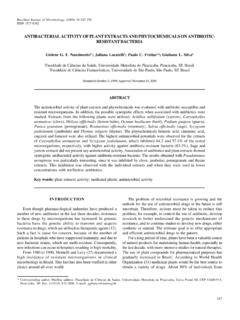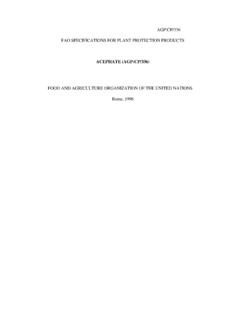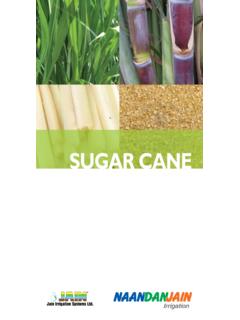Transcription of Physical and chemical properties of granulated …
1 Ci ncia e Tecnologia de Alimentos ISSN 0101-2061. Physical and chemical properties of granulated cane sugar panelas . Propriedades f sicas e qu micas de rapaduras granuladas Marisa Josefina GUERRA1*, Mar a Virginia MUJICA2. Abstract Panela is a natural sweetener obtained by concentrating sugar cane juice and handmade in small factories. In the study carried out, the Physical and chemical properties of two commercial brands of artisanal granulated panelas and of one made on an experimental level were determined. Three lots of each sample were analyzed. The parameters measured were moisture, aw, protein, ash, minerals, reducing sugars, sucrose, pH, color (L, a and b), insoluble solids (IS), transmittance a 720 nm and filterability. In addition, a qualitative test to detect sulphur dioxide was performed. The parameters with higher variability were moisture ( g 1), aw ( ), reducing sugars ( g 1), pH ( ), and color.
2 Potassium was the most abundant mineral ( g 1). An inverse relationship between IS and transmittance at 720 nm (R2 = ) and a direct relationship between IS and ash (R2 = ) were found. The sulphur dioxide test was negative for all the samples. Keywords: sweetener; sugar cane; artisanal; minerals; reducing sugars; insoluble solids; panelas; Physical and chemical properties . Resumo A rapadura um ado ante natural obtido pela concentra o do suco de cana-de-a car e elaborado artesanalmente em pequenas f bricas. No estudo realizado, se determinaram as propriedades f sicas e qu micas de rapaduras granuladas artesanais de duas marcas comerciais e de uma produzida em n vel experimental. Analisaram-se tr s lotes de cada amostra. Os par metros medidos foram umidade, aw, prote na, cinzas, minerais, a cares redutores, sacarose, pH, cor (L, a e b), s lidos insol veis (SI), turbidez e filtrabilidade. Tamb m se realizou uma prova qualitativa para detectar di xido de enxofre.
3 Os par metros de maior variabilidade foram umidade ( g 1), aw ( ), a cares redutores ( g 1), pH ( ) e cor. O pot ssio foi o mineral mais abundante. Encontrou-se uma rela o inversa entre SI e turbidez (R2 = 0,96) e uma rela o direta entre SI e cinzas (R2 = 0,94). A prova de di xido de enxofre resultou negativa para todas as amostras. Palavras-chave: ado ante; cana-de-a car; artesanal; minerais; a cares redutores; s lidos insol veis; rapadura; propriedades f sicas e qu micas. 1 Introduction Panela is a solid natural product, obtained by concentrating in Chile and Peru, panela in Colombia, Ecuador, Guatemala sugar cane juice previously clarified (NTC 1311, 1991), and and other Central American countries, panela or piloncillo in traditionally commercialized in blocks of different shapes Mexico, and papel n or panela in Venezuela. FAO statistics and sizes. This foodstuff can be considered a whole sweetener record it as uncentrifuged sugar.
4 (KUMAR; TIWARI, 2006), as it preserves most of the compounds Panela is produced in 25 countries, Venezuela among present in sugar cane juice, and therefore, it is expected that its them, with a world annual production of million tonnes nutritional value is higher than that of refined sugar. (FAOSTAT, 2003). The manufacture of panela is concentrated It has been shown that panela has medicinal properties , in Asia and South America, the major producers being India for example, preventing lung lesions induced by smoke, due ( million tonnes) and Colombia ( million panela to its antitoxigenic and anticarcinogenic properties (SAHU; tonnes). PAUL, 1998; SAHU; SAXENA, 1994) and to the reduction of On a world scale, the agro-industry rural in nature, with the clastogenic effect caused by arsenic (SINGH et al., 2008;. a clearly artisanal process controlled by the experience of HAIDER et al., 2007; SINGH; KUMAR; SAHU, 2006).
5 In the operators, which leads to the lack of standardization in addition, it has a potential antioxidant activity owing to the both the process and the quality of the product (MUJICA;. presence of polyphenolic compounds in cane juice (HARISH. GUERRA; SOTO, 2008; MOSQUERA; CARRERA; VILLADA, et al., 2009; PAYET; CHEONG; SMADJA, 2006). 2007; HERN NDEZ; AMAYA; GIRALDO, 2002; PAWAR;. Panela is known by many different names: gur and DONGARE, 2001). This, together with the little knowledge jaggery in India and Pakistan, rapadura in Brazil, chancaca consumers have about the nutritional and medicinal benefits of Recebido para publica o em 18/5/2008. Aceito para publica o em 8/7/2009 (003523). 1. Departamento de Tecnolog a de Procesos Biol gicos y Bioqu micos, Universidad Sim n Bol var, Caracas 1090A, Venezuela, E-mail: 2. Departamento de Procesos Agroindustriales, Universidad Centroccidental Lisandro Alvarado, Barquisimeto 3001, Venezuela *A quem a correspond ncia deve ser enviada Ci nc.
6 Tecnol. Aliment., Campinas, xx(x): x-x, xxxx x Physical and chemical properties the panela and the impractical use of its traditional presentations, Previously, a solution of ashes was prepared following the contributes to its consumption being much lower compared to Venezuelan standard COVENIN 1178-83 (1983). To the residue that of refined sugar. of the ash determination, 5 mL of a hydrochloric acid solution (1:1) were added and heated on an electric hot plate until dry;. The development of new presentations is one of the strategies another 5 mL were added and it was heated for 30 minutes. The to promote the consumption of panela. The granulated product, resulting solution was filtered to a 100 mL volumetric flask, a form that has recently entered the Latin American market, is the filter paper with the remaining insoluble ash residue was obtained by concentrating sugar cane juice until a thick syrup incinerated and 5 mL of hydrochloric acid (1:1) were added, and is achieved, which granulates when beaten (NTE INEN 2 332, it was heated for 5 minutes.)
7 This solution was filtered into the 2002). In some cases, an air current (at room temperature). same volumetric flask, the crucible was rinsed, and the flask was by forced convection is applied, simultaneously to beating, to filled to capacity with distilled water. A reagent blank solution promote dehydration of the product and thus its granulation. was prepared likewise. The concentration of each mineral was The use of the granulated product has advantages compared expressed as g 1 sample (dry basis). to the block presentation, as it is easier to measure, more stable during storage, and more soluble. Due to its high proportion of aw sucrose and the advantages already mentioned, it can be used in the same way as sugar (beverages, desserts, and sweet and Water activity was determined using a Decagon CX-2. sour preparations). (AquaLab, USA), which uses a psychrometric method based on the cooled mirror technique.
8 The objective of this research was to determine the Physical and chemical properties of artisanal granulated panelas and of one produced at experimental level. Three lots were analyzed pH. from each sample, in order to characterize the product and pH was determined with a pH Meter (Coleman 39, USA). evaluate the variability among samples and among lots. In in a 10% w/w panela solution, at room temperature, following addition, some variables were correlated in order to find the a modified version of the Prada (2002) method. most suitable ones to evaluate the quality of the product. Color 2 Materials and methods Tristimulus color was determined using a spectrocolorimeter (Hunterlab Miniscan XE 45/0, USA). The readings were Sample acquisition performed in terms of L, a and b. Lightness value, L, indicates Two commercial brands, A and B, produced in two how dark/light the sample is (varying from 0-black to municipalities of the Tachira State, in the west of the Venezuela, 100-white), a is a measure of greenness/redness (varying from were analyzed.)
9 The experimental panela was manufactured at 60 to +60), and b is the grade of blueness/yellowness (also a pilot plant level by the CIEPE (Centro de Investigaciones varying from 60 to +60). For each replica, the mean of three del Estado para la Producci n Experimental Agroindustrial) readings was taken. Foundation. Three lots of each product were analyzed, and in all cases, the sampling took place at the production site. Insoluble solids Insoluble solids were quantified with a modified version of Sample preparation the Prada (2002) method. g of sample were weighed, and Prior to the analysis, the samples were ground in a mill 20 mL of distilled water were added; it was agitated on an electric (HQ Analyzer MC-II, Argentina) up to a particle size smaller hot plate for 30 minutes and filtered through a MFS membrane than mm. with a pore diameter of m, made with a mixture of cellulose esters, in a stainless steel filtration unit (Sartourius A.
10 Physical and chemical characterization G 16828, Germany). Once the sample was suctioned, two rinses of the membrane were performed with 30 mL of distilled water;. this was later dried in an oven (Memmert 25, Germany) at Moisture, protein, ash, reducing sugars and sucrose 100 C for 3 hours. It was weighed, and the dehydration process Official AOAC (1990) methods for sugars and sugary continued until a constant weight was achieved. The content of products were used. The nitrogen content was multiplied by insoluble solids was expressed as g per 100 g dry basis. to calculate the protein concentration in the sample. Results were reported on dry basis (except moisture) in g 1 of sample. Turbidity (transmittance a 720 nm). The analysis was performed with a modified version of the Minerals Prada (2002) method. For this, a solution of the sample at 5%. Minerals analyzed were potassium, calcium, phosphorus, w/v (dry basis) was prepared and divided in two portions; one magnesium, sodium, iron, zinc, manganese, and copper, using of them was filtered through a paper equivalent to a Whatman inductively coupled plasma-atomic emission spectroscopy (ICP N 1 using siliceous earth as filtering aid and used as a blank.













